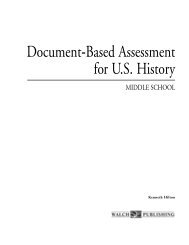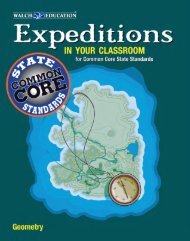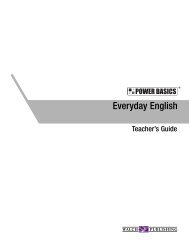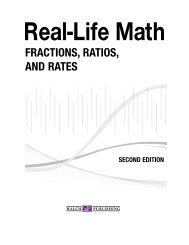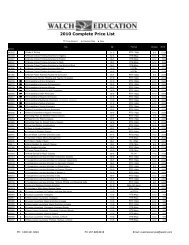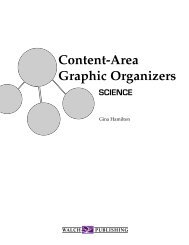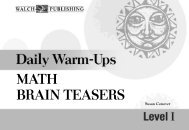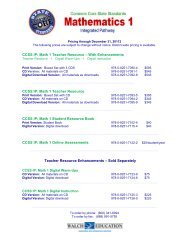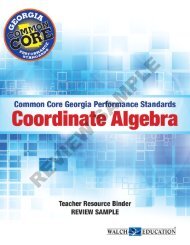Everest Trek - Walch Education
Everest Trek - Walch Education
Everest Trek - Walch Education
You also want an ePaper? Increase the reach of your titles
YUMPU automatically turns print PDFs into web optimized ePapers that Google loves.
TABLE OF CONTENTSIntroduction .............................................. vOrganization and Structure of <strong>Everest</strong> <strong>Trek</strong> ...................... viiBuilding Math: Pedagogical Approach, Goals, and Methods ......... viiiEnduring Understandings ................................... ix<strong>Everest</strong> <strong>Trek</strong> Overview: Story Line and Learning Objectives .......... xAssessment Opportunities and Materials Lists .................... xi<strong>Everest</strong> <strong>Trek</strong> Master Materials List ............................. xiiiCommon Core and ITEEA Standards Correlations ............... xivPacing Planning Guide .................................... xxCup-Stack Team-Building Activity ............................. 1<strong>Everest</strong> <strong>Trek</strong> Prerequisite Math Skills ............................ 2Writing Heuristics, or Rules of Thumb ......................... 15<strong>Everest</strong> <strong>Trek</strong> Introduction ................................... 16Introducing the Engineering Design Process (EDP) ............... 22Design Challenge 1: Gearing Up! ............................ 28Design Challenge 2: Crevasse Crisis! .......................... 69Design Challenge 3: Sliding Down! .......................... 106Resources & Appendices .................................... 135EDP: Engineering Design Process ......................... 136Math and Engineering Concepts .......................... 138Important Vocabulary Terms ............................. 138Rubrics ............................................. 140Student Work Samples .................................. 146Answer Key ............................................. 155© Museum of Science (Boston), Wong, Brizuela <strong>Everest</strong> <strong>Trek</strong> iii
EVEREST TREK OVERVIEW: STORY LINE AND LEARNINGOBJECTIVESDESIGN CHALLENGEOVERVIEWSTUDENTS WILL:DESIGN CHALLENGE 1: GEARING UP!Students imagine that they arepreparing to climb Mount <strong>Everest</strong>.They learn about the climateconditions and need to design acoat to protect them from the coldand wind. Students research theinsulation performance of differentmaterials to help determine whichmaterials to choose for their design.The coat must keep the temperatureabove 65˚F for 30 seconds, notexceed a thickness of 2 cm, and beas low in cost as possible.• Interpret a line graph.• Locate and represent the range of acceptable values on agraph to meet design criteria.• Extrapolate data based on trends.• Conduct two controlled experiments.• Collect experimental data in a table.• Produce and analyze graphs that relate two variables.• Determine when it’s appropriate to use a line graph or ascatter plot to represent data.• Distinguish between independent and dependent variables.• Apply the engineering design process to solve a problem.DESIGN CHALLENGE 2: CREVASSE CRISIS!As students are “climbing” Mount<strong>Everest</strong>, they come to a largecrevasse. They study the saggingeffect of loading weight onto bridgesof different sizes and shapes todesign a bridge that will enablethem to safely cross the crevasse.The bridge must meet these criteriaand constraints: It should support aminimum amount of weight withoutsagging more than a specific amount,use as few ladders as possible forconstruction, and be a minimumwidth to allow for safe crossing.• Use proportional reasoning to determine dimensions for ascale model.• Use physical and math models.• Conduct two controlled experiments.• Collect experimental data in a table.• Produce and analyze graphs that relate two variables.• Compare rates of change (linear versus non linearrelationships).• Distinguish between independent and dependentvariables.• Apply the engineering design process to solve a problem.DESIGN CHALLENGE 3: SLIDING DOWN!Students have reached the top ofMount <strong>Everest</strong>. But now they facethe problem of altitude sicknessand a need to quickly transporttheir sick classmates down themountain. Students experimentto find a relationship between theangle of a zip-line and the speed ofmoving along the zip-line down themountain. Students use the resultsof their research to design a zip-linetransportation device that meetsthese criteria and constraints: It mustmove within a range of acceptablespeeds, be stable and secure, andinclude a return mechanism.• Conduct a controlled experiment.• Measure angles using a protractor.• Compare and discuss appropriate measures of centraltendency (mean, median, mode).• Apply the distance-time-speed formula.• Produce and analyze a graph that relates two variables.• Locate and represent the range of acceptable values on agraph to meet a design criteria.• Distinguish between independent and dependentvariables.• Apply the engineering design process to solve a problem.x <strong>Everest</strong> <strong>Trek</strong>© Museum of Science (Boston), Wong, Brizuela
COMMON CORE AND ITEEA STANDARDS CORRELATIONSThe following tables show how each design challenge addresses Common Core StateMathematics Standards and International Technology and Engineering Standards. In theCommon Core column, double asterisks (**) denote standards that are not expressly addressedby the design challenges, but that can be addressed by using optional suggestions included in theinstructional text for that design challenge. References to the specific pages are included.Common Core State Standards forMathematics (Grades 6–8) 1ITEEA Standards for Technological Literacy(STL) 2DESIGN CHALLENGE 1: GEARING UP!Mathematical Practices2. Reason abstractly and quantitatively.3. Construct viable arguments and critique thereasoning of others.6. Attend to precision.Standards6.RP.3. Use ratio and rate reasoning to solve realworldand mathematical problems, e.g.,by reasoning about tables of equivalentratios … double number line diagrams**,or equations**.**See Optional CCSS Enhancement(s)on page 38.b. Solve unit rate problems includingthose involving unit pricing andconstant speed.6.NS.3. Fluently add, subtract, multiply, and dividemulti-digit decimals using the standardalgorithm for each operation.6.NS.6.a. Recognize opposite signs of numbers asindicating locations on opposite sides of0 on the number line; recognize that theopposite of the opposite of a number isthe number itself, e.g., –(–3) = 3, andthat 0 is its own opposite.****See Optional CCSS Enhancement(s)on page 32.6.NS.6.b. Understand signs of numbers in orderedpairs as indicating locations in quadrantsof the coordinate plane; recognize thatwhen two ordered pairs differ only bysigns, the locations of the points arerelated by reflections across one or bothaxes.****See Optional CCSS Enhancement(s)on page 41.1F New products and systems can be developedto solve problems or to help do things that couldnot be done without the help of technology.1G The development of technology is a humanactivity and is the result of individual and collectiveneeds and the ability to be creative.1H Technology is closely linked to creativity, whichhas resulted in innovation.2R Requirements are the parameters placed onthe development of a product or system.2S Trade-off is a decision process recognizing theneed for careful compromises among competingfactors.8E Design is a creative planning process that leadsto useful products and systems.8F There is no perfect design.8G Requirements for design are made up ofcriteria and constraints.9F Design involves a set of steps, which can beperformed in different sequences and repeated asneeded.9G Brainstorming is a group problem-solvingdesign process in which each person in the grouppresents his or her ideas in an open forum.9H Modeling, testing, evaluating, and modifying areused to transform ideas into practical solutions.11H Apply a design process to solve problems inand beyond the laboratory-classroom.1Common Core State Standards. Copyright 2010. National Governor’s Association Center for Best Practices and Council ofChief State School Officers. All rights reserved.2International Technology and Engineering Educators Association (ITEEA). 2007. Standards for Technological Literacy:Content for the Study of Technology. (Third ed.) Virginia.xiv <strong>Everest</strong> <strong>Trek</strong>© Museum of Science (Boston), Wong, Brizuela
Teacher PageDesign Challenge 1Gearing Up!INTRODUCTIONOBJECTIVE: Students will read and understand the problem presented for the first designchallenge.CLASS Together, read the introduction on the next page.ASK THE CLASS:• Have you ever been caught outside in cold weather without a coat? Why is itdangerous for the human body to be exposed to freezing temperatures withoutproper protection?Possible Answer(s): Exposure can lead to frostbite, organ failure, and so forth.!INTERESTING INFOHypothermia results in lowered body temperature and slowed physiologicalactivity. Hypothermia is sometimes artificially induced (usually with icebaths) for certain surgical procedures and cancer treatments. Accidentalhypothermia can result from falling into cold water or from overexposurein cold weather. Hypothermia becomes serious when body temperature fallsbelow 35˚C (95˚F). It is considered an emergency when body temperaturegoes below 32.2˚C (90˚F), at which point shivering stops. Pulse, respiration,and blood pressure are depressed. Even when the victim appears dead, revivalmay be possible with very gradual rewarming.28 <strong>Everest</strong> <strong>Trek</strong> © Museum of Science (Boston), Wong, Brizuela
DesignChallenge 1Gearing Up!INTRODUCTIONYour team is equipped and ready to climb Mount <strong>Everest</strong>!Upon arriving at base camp, you turn on the radio and hear thefollowing weather report for the summit of Mount <strong>Everest</strong>:“For all you new climbers out there, be prepared for someextreme temperatures on the glacier‐covered mountain.In January, the coldest month, the summit temperatureaverages –36 ° C and can drop as low as –60 ° C. In July,the warmest month, the average summit temperature is–19 ° C. At no time of the year does the temperature onthe summit rise above freezing. For the next few weeks,we are expecting an average temperature near –26 ° C.”© Museum of Science (Boston), Wong, Brizuela <strong>Everest</strong> <strong>Trek</strong> 29
Teacher Page1. DEFINE THE PROBLEM: GEARING UP!OBJECTIVE: Students will read and understand the criteria and constraints of the designchallenge.CLASS Together, read the engineering criteria and constraints.ASK THE CLASS:• What types of insulators have you seen used in real life?Possible Answer(s): jackets, blankets, walls• What materials make up these insulators?Possible Answer(s): down feathers, fiberglass, wool• What characteristics of the material make it an effective insulator?Possible Answer(s): thick, fluffy, multi-layered• Of the four materials you will use in your coat design, which one do you think will bethe best insulator? Which one will be the worst? Why?Possible Answer(s): Answers will vary.• Why do you think the criterion is that the temperature must remain above 18˚C?Possible Answer(s): 18˚C is the standard room temperature at which most humansare comfortable.!INTERESTING INFO: Math ProblemBase camp instructors are providing climbers with extra clothing because offreezing temperatures in the mountain. The only problem is, your backpackcan’t exceed 22.75 kg or reaching the summit would become seeminglyimpossible. Right now, your backpack is 21.75 kg. Which article(s) ofclothing will keep you the warmest without exceeding 22.75 kg? Defend yourchoice.Possible Answer(s): Basically, any combination that totals less than 1000 g:1 thermal jacket; 1 parka and 1 T-shirt; 1 fleece jacket and 1 crew shirt;4 crew shirtsCLOTHING WEIG HT S UITAB LE TEMPERATURERANG ESFleece jacket 618 g 4°C—13°CParka 800 g –7°C—2°CThermal jacket 927 g –18°C— –4°CLong-sleeve crew shirt 238 g 18°C—24°CT-shirt 196 g 24°C and up30 <strong>Everest</strong> <strong>Trek</strong> © Museum of Science (Boston), Wong, Brizuela
NameSTUDENT PAGE81 1 27 36 45DEFINE1. DEFINE THE PROBLEM: GEARING UP!When any part of your body is exposed to freezing temperatures for more than a fewminutes, you are at risk for getting frostbite. Therefore, you will need to dress in outerwearthat can keep your body warm in these extremely cold temperatures. Your task is to design acoat that is made of a good insulator to keep you warm, is thin enough to allow you to moveeasily, and is low in cost.ENG INEERING CRITERIAGOOD INSULATORTHINLOW COSTWhen surrounded by ice, the material must keep thetemperature above 18°C for 30 seconds.The total thickness of the materials must not exceed2 cm.Your coat design should be as low in cost aspossible.ENG INEERING CONSTRAINTSYou are limited to the following materials for your coat design:• denim• fleece• nylon• wool© Museum of Science (Boston), Wong, Brizuela <strong>Everest</strong> <strong>Trek</strong> 31
ANSWER KEYPAGES 4–8LINE GRAPH ACTIVITYExercise 11. Mileage; it is an “input.”2. Value; it is an “output.”3. x mileage (independent variable)4. y value (dependent variable)5. a. 0–120,000; 120,000b. 25c. 120,000, 25; data range is greater than number of boxes so 120,000 ÷ 25 = 4,800d. Every box is worth 4,800.e. x-axis should be labeled “Mileage” with appropriate units.6–7. See sample graph; answers will vary.Sample graph:Relationship Between Truck Mileage and Value181716151413Value in thousands of $121110987654321010 20 30 40 50 60 70 80 90 100 110 1208. Answers will vary. Mileage in Thousands of Kilometers9. $3,50010. 20,000–40,000 kilometers11. $6,50012. $2,500, by extending the line or estimating the next decrease based on the previous decrease156 <strong>Everest</strong> <strong>Trek</strong> © Museum of Science (Boston), Wong, Brizuela



